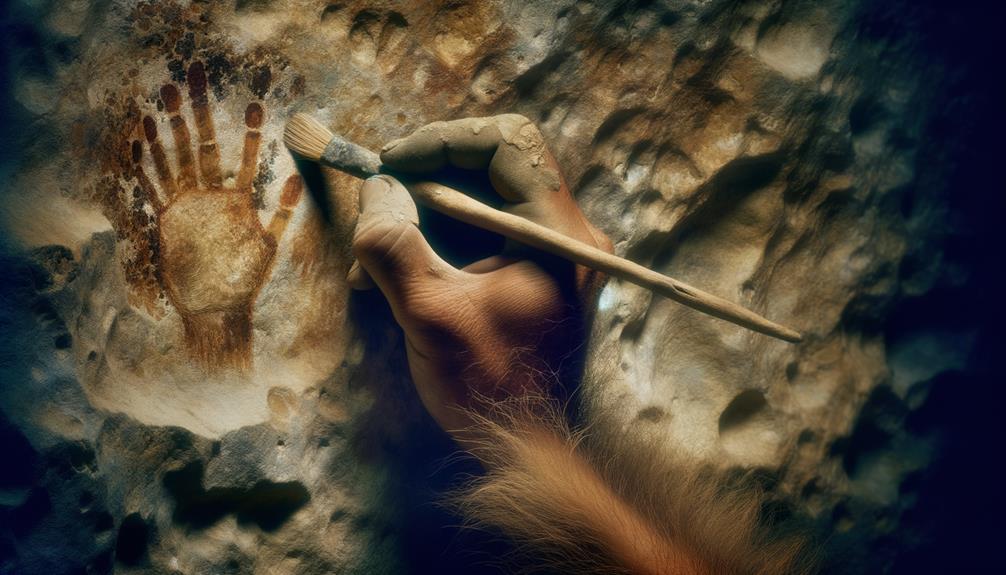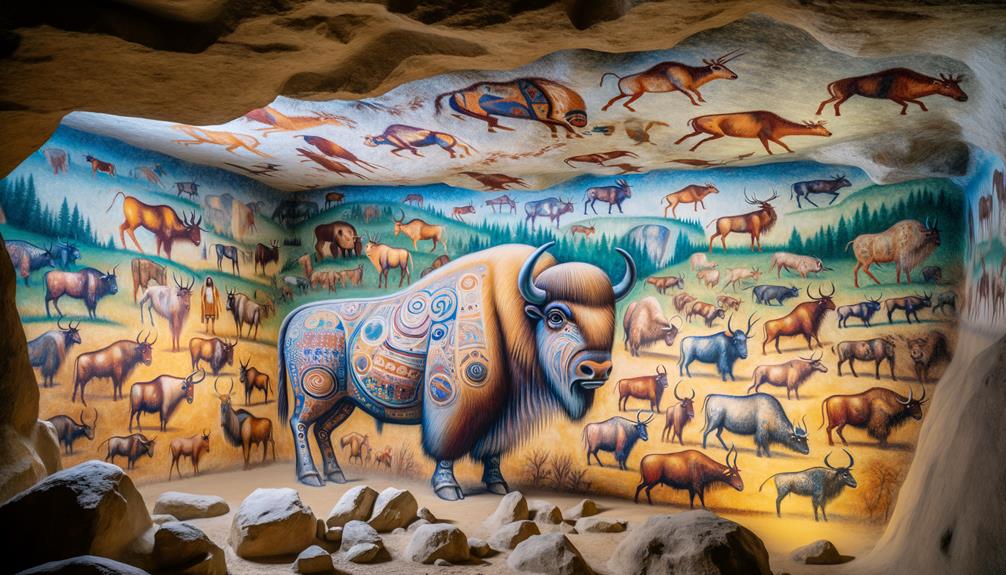The Lascaux Cave paintings, crafted over 17,000 years ago, are a captivating look at prehistoric art. These works reveal an unexpected level of artistic sophistication for their age, making us feel closer to our Stone Age forebears. More than 2,000 vibrant images of animals, people, and symbols, made using natural pigments, show us that these paintings were more than just art. They were deeply symbolic and connected to the natural world around them. Preserving these ancient works is a constant challenge, but thanks to current efforts to conserve them, we’re still able to marvel at this beautiful piece of history. There’s still so much more to learn and understand, should you choose to continue on this fascinating journey.
Discovery of Lascaux Cave
One day in September 1940, Marcel Ravidat and his pals found something extraordinary – the Lascaux Cave. This cave, with its complex animal drawings on the walls, is a jewel from our ancient past. Its finding was a pivotal point in our understanding of human history, showing us clear links to our early ancestors. In 1948, they opened the cave to the public, sparking interest and awe across the globe. But, there was an unforeseen downside. The influx of visitors started to harm the cave’s fragile ecosystem. By 1955, the artwork on the walls had started to fade and deteriorate. To protect this invaluable part of our history, they decided to close the cave in 1963. They installed a monitoring system instead, to keep an eye on it. The story of the Lascaux Cave, from its unearthing to its closure, is a stark reminder of our duty to protect our shared past.
Artistic Techniques Used

Taking a closer look at the Lascaux cave paintings, it’s evident that the artists of this prehistoric era had an impressive grasp of artistry and realism. It’s truly intriguing how these early painters, with only natural pigments and basic tools at their disposal, were able to craft such vibrant scenes on the cave walls.
- The paint they used was a concoction of iron compounds and pigments that contained manganese, mixed with animal fat or groundwater from the cave.
- Implements like sponges made from animal skin were their brushes, while hollow bones served as basic versions of today’s spray paint cans.
- Adding to the painted images, they also etched designs directly onto the rock surface.
The level of understanding and skill these techniques display is quite astounding, especially considering the time when these works were created. This is particularly apparent in the Lascaux Cave paintings.
Significance of Animal Imagery

When we take a look at the Lascaux cave paintings, we’re met with a stunning array of animal figures. From bison to horses to deer, they’re depicted with such vivid colours and impressive detail. For those who lived during prehistoric times, these animal figures were more than just a beautiful sight – they were deeply symbolic and tied to their spiritual beliefs and customs.
Some experts think that these animal depictions could be tied to hunting magic, a way for early humans to try and increase their hunting success. The fact that we see so much of this animal imagery gives us a unique window into the lives of our ancient ancestors. It shows us how deeply connected they were with the world around them.
These masterpieces allow us to see how art, belief, and survival were all intertwined. They show us that animals were much more than just a source of food for our ancient ancestors – they were a key part of their worldview.
Threats to Preservation

The Lascaux cave paintings are a breathtaking sight to behold, steeped in history and telling tales from a time long past. However, these remarkable works of art are in danger, primarily due to environmental issues such as fungus and mold.
What’s causing this? One of the main culprits is a persistent fungal disease. Believe it or not, the installation of air conditioning and artificial lights are contributing to the problem. These changes have upset the delicate balance of the cave’s microclimate, making the preservation of the paintings even more challenging.
Here are some alarming incidents:
- There was an outbreak of black mold in 2006, which made preserving the paintings even more difficult.
- A symposium on Lascaux shed light on the urgent need for conservation.
- The cave had to be closed for three months in 2008 to keep a close watch on the conditions inside.
These threats are serious, and they highlight the importance of putting in place robust and strategic measures to safeguard this irreplaceable prehistoric masterpiece. It’s not just about preserving a piece of art – it’s about protecting a piece of our shared human history.
Archaeological Studies and Interpretations

Taking a closer look at the Lascaux cave paintings through the lens of archaeology, it’s fascinating to see the multitude of figures that have been uncovered. Many experts in the field suggest that these paintings hold a special significance related to the success of hunting, which could be tied to rituals or magic. This idea gets traction when you consider the artistic methods and the storytelling layout of the figures. Alongside the continuous work to study and conserve these works, our goal is to interpret the symbolisms hidden in this prehistoric art. We’re also committed to protecting these age-old artworks for future generations to appreciate.
Unearthing Lascauxs Mysteries
Unearthing the secrets of Lascaux, researchers have found more than 2,000 intriguing figures that portray animals, human shapes, and abstract symbols. This prehistoric cave, unearthed in 1940, is recognized as a UNESCO World Heritage site and provides a captivating look into the Stone Age. The creators of these artworks utilized natural pigments to craft the cave drawings, a type of wall art, that exhibit an impressive level of talent and comprehension.
- The Lascaux Cave paintings present a variety of animal depictions,
- The artistic techniques employed highlight a remarkable level of sophistication for the time,
- The cultural value of these paintings continues to be a topic of research and interpretation.
These elements add to the lasting charm and significance of Lascaux, mirroring the artistic abilities of our forebears.
Symbolism in Prehistoric Art
Let’s take a closer look at the world of symbols and spirituality, particularly through the lens of archaeology. The Lascaux Cave paintings, for instance, aren’t just random depictions of animals – there’s a whole lot more to them. These paintings are thought to be rich with symbolism and may even hold spiritual or ritualistic significance.
The people who created these artworks weren’t just artists – they were deeply connected to their culture and beliefs, and it’s likely that their creations played a role in certain ceremonies, possibly even those of a shamanistic nature. The careful detailing and thoughtful arrangement of the animals suggest they were communicating something profound, perhaps a sacred dialogue with the spiritual realm.
When we look at it from this perspective, the Lascaux Cave becomes more than just an ancient art gallery. It’s a canvas filled with myths and meanings. As we continue to interpret these symbols, we’re able to gain a deeper understanding of our ancestors and their dynamic interaction with the world around them. This, in turn, provides us with a richer perspective on our own history.
Preservation of Lascaux Paintings
Let’s chat about how we’re working to protect the Lascaux paintings. It’s like a tug of war with time and the environment, especially with the rise of fungi and black mold since 2000 threatening the conservation efforts. When the cave doors were closed in 2008, it gave us a chance to really look at these threats and think about how to safeguard these paintings. A group of experts even got together to talk it out and came up with some solid ideas.
- We’ve got to get a handle on the fungal disease in the cave, pronto.
- We can make smarter choices in how we go about conserving the paintings.
- Maybe we should use 3D replicas to limit how much humans touch the original art.
The future of these invaluable masterpieces is hanging by a thread, with microorganisms, changes in the environment, and time itself proving to be tough opponents. But we’re not backing down. We’re committed to staving off deterioration and loss.
Visiting Lascaux: Practical Information

If you’re a fan of ancient artwork, you should definitely consider checking out the Lascaux caves. Well, not the actual caves, but rather their replicas. The replicas recreate the original cave paintings with remarkable detail, allowing you to fully appreciate the prehistoric art. One of them, Lascaux II, reproduces the Great Hall of the Bulls and the Painted Gallery, which are some of the most impressive parts of the original cave.
But the replicas don’t stop at Lascaux II. Lascaux III, for example, contains five exact reproductions of the cave paintings, and it travels around the world to share these works of art with as many people as possible. Then there’s Lascaux IV, which uses modern technology to create an immersive experience for visitors. And let’s not forget about Le Parc du Thot, the Center of Prehistoric Art, which displays a comprehensive collection of Lascaux’s wall art.
These replicas aren’t just copies of the original paintings. They’re a way to connect with and understand our history and the creative minds of our ancestors. So, if you’re interested in art or history, visiting them would be a truly enriching experience.
Frequently Asked Questions
What Prehistoric Cave Paintings at Lascaux Include?
The Lascaux cave paintings showcase an array of large animals, like horses, bulls and deer, along with human shapes and some ambiguous signs. It’s fascinating to see just how artistically skilled our forebears from the Upper Paleolithic era were.
What Is the Significance of the Lascaux Cave Paintings?
Isn’t it fascinating how simple ancient markings inside a cave can drastically transform our understanding of history? The drawings found in Lascaux are more than just art. They give us a glimpse into how our forebears lived, what they believed in, and how their societies functioned. These paintings are a testament to the remarkable ingenuity of our ancestors.
What Are the 3 Famous Cave Paintings in Prehistoric Art?
When we talk about the world of prehistoric art, three remarkable cave paintings really stand out. We have the Hall of the Bulls, the Painted Gallery, and the Shaft of the Dead Man. Each one of these holds its own unique charm and provides insightful glimpses into their respective cultures.
What Famous Ancient Art Was Discovered in Lascaux France?
Can you imagine stumbling upon a huge collection of ancient art, right in Lascaux, France? That’s exactly what happened! Found there were almost 2,000 figures, primarily showcasing big animals, that give us a glimpse into the surprisingly sophisticated artistic skills of our ancestors. And would you believe it, these masterpieces were created around 20,000 years ago!


